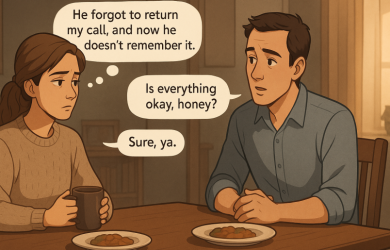How to Deal With Passive-Aggressive People in the Family

Unlock Daily 30-Sec Tips for a Happier Relationship
👉 Subscribe FREEKey Takeaways
Marriage.com AI Quick Summary
Dealing with passive-aggressive people in the family can feel like walking on eggshells. The constant tension, sarcastic comments, or subtle digs leave you questioning:
Why can’t they just say what they really mean? If this sounds familiar, you’re not alone.
Imagine you ask a family member to help with something, and they respond with a smile but follow it up with an offhand remark like, “I guess I’ll do it since no one else can be bothered.”
They don’t directly confront you, but you can feel the frustration simmering beneath the surface. This is passive-aggressive behavior at its finest.
How do you handle these tricky situations? What can you do when someone’s actions don’t match their words? How do you protect your own peace while dealing with passive-aggressive people?
In this article, we’ll dive into these questions and offer practical strategies for coping with passive-aggressive behavior, especially within your family.
According to experts, the key to dealing with this behavior is understanding the root cause and responding calmly, rather than escalating the situation. Let’s break it down and find ways to restore healthy communication in your family dynamic.
What does passive-aggressive personality mean in family relationships?
A passive-aggressive personality in family relationships can create confusion and frustration because the individual expresses negative feelings indirectly. Rather than confronting issues head-on, they tend to bottle up their emotions and let them leak out in subtle, indirect ways.
For instance, a family member might not say they are angry about a situation, but instead, they might make sarcastic remarks like, “It’s fine, I’ll just do it myself, as usual,” when asked to help.
This type of indirect communication can make it hard to know how to respond or address the problem because the feelings are never expressed clearly.
In family setups, passive-aggressive behavior often manifests as avoidance of confrontation.
Instead of saying, “I’m upset,” the person may act in ways that show frustration, like being quiet or doing something poorly on purpose.
For example, a person might agree to a family gathering but then show up late or act uninterested, signaling their discontent without saying anything directly. This leaves other family members feeling confused, unsure whether there’s a deeper issue or if the person is simply not invested in the family event.
The passive-aggressive behavior in families makes it difficult to address underlying issues. When feelings aren’t openly communicated, problems can build up over time, leading to long-term misunderstandings.
It becomes harder to resolve conflicts because the emotional tension remains unspoken, and no one can truly understand where the other person stands.
How to spot passive-aggressive behavior in your family
Spotting passive-aggressive behavior in your family can be tricky, but it often shows up in subtle, indirect ways. Here are a few examples to help you identify it:
- Sarcastic comments: If a family member says something like, “Oh, I’m so glad you’re finally helping out,” instead of expressing gratitude or frustration directly, they use sarcasm to mask their true feelings. This leaves you unsure if they’re genuinely happy or upset.
- Procrastination or doing things poorly on purpose: For example, if a family member agrees to help clean up but takes forever or does it badly, it’s a passive-aggressive way of expressing their frustration without directly confronting the issue. Instead of saying, “I don’t want to help,” they let their actions speak.
- Silent treatment: If someone in your family suddenly stops talking or becomes withdrawn without explanation, they might be upset but unwilling to express it directly. They’re using silence as a way to avoid confrontation and to show disapproval without saying anything.
- Agreeing outwardly but acting resentful: A family member might agree to attend a family event or participate in a plan but then display signs of irritation or reluctance, like showing up late or acting uninterested. Instead of saying they’re not excited about it, they show it through their actions.
How to deal with passive-aggressive people in your family
Passive-aggressive behavior in a family can be emotionally draining. Instead of openly discussing their frustration, family members may use sarcasm, silent treatment, procrastination, or guilt trips to express their resentment.
This kind of behavior can create tension and confusion, making it difficult to maintain healthy relationships. So, how do you handle it without getting trapped in their negativity? Here are seven practical ways to navigate these tricky interactions.
1. Recognize the behavior for what it is
The first step to dealing with passive-aggressive people is understanding their behavior. It may show up as subtle jabs, backhanded compliments, or indirect resistance, like a sibling who “forgets” to do their share of house chores as a form of silent protest.
Instead of feeling guilty or frustrated, recognize that this is their way of expressing hidden resentment. Once you identify it, you can handle it with more clarity and patience.
2. Don’t take the bait
Passive-aggressive people often make subtle digs to provoke a reaction. For example, your parent might say, “Oh, I see you finally decided to call me,” instead of directly expressing that they miss you.
If you react angrily, they may turn it back on you, saying, “I was just joking!” The best approach is to stay neutral and not give them the emotional reaction they seek. Instead, you can respond with something lighthearted like, “Yep! Just wanted to check in.”
Related Reading: https://www.marriage.com/advice/mental-health/passive-aggressive-things-to-say/
3. Encourage direct communication
Many passive-aggressive people struggle to express their feelings openly. They might feel uncomfortable with confrontation or fear rejection, so they resort to indirect expressions of their emotions. If you notice someone acting distant or sarcastic, gently invite them to talk.
For example, if your spouse seems irritated but won’t say why, you could say, “You seem upset. Do you want to talk about what’s bothering you?” Encouraging open dialogue can help break the cycle of indirect resentment.
Learn dealing with passive agressive comments effectively with this video:
4. Set clear boundaries
If a family member constantly uses guilt trips or silent treatment, it’s important to establish boundaries.
For example, if your sibling keeps saying, “I guess I’ll just do everything myself since no one cares,” instead of asking for help directly, you can respond by saying, “If you need help, just ask. I can’t guess what you need.”
This helps shift the responsibility onto them to communicate openly rather than play mind games.
5. Stay calm and don’t mirror their behavior
It’s easy to fall into the trap of responding to passive-aggressive behavior with more of the same. If a family member is being cold or sarcastic, you might be tempted to act the same way. However, this only escalates the tension. Instead, maintain a calm and assertive tone.
If your partner gives you the silent treatment, don’t beg for a response—continue with your day as usual. Your calmness will show that their tactics won’t get the reaction they want.
6. Address the behavior, not the person
Instead of accusing them by saying, “You’re so passive-aggressive,” focus on the specific behavior.
For example, if your mom keeps making sarcastic remarks about your choices, instead of snapping, “Why are you always like this?” say, “I noticed that you make jokes about my decisions a lot. If you have concerns, I’d rather hear them directly.”
This approach prevents them from feeling personally attacked while still calling out their behavior.
7. Know when to walk away
Some passive-aggressive people will refuse to change, no matter what you do. If a family member consistently avoids direct communication, refuses to respect your boundaries, or continues using manipulation, you may need to step back.
For example, if an aunt constantly makes snide comments about your life choices, despite multiple attempts to address it, it’s okay to limit your interactions with her. You can’t force someone to be direct, but you can control how much their negativity affects you.
FAQs
Here are some common questions about handling passive-aggressive behavior and practical ways to respond.
-
How do you outsmart a passive-aggressive person who’s related to you?
Actually, you don’t need to “outsmart” them—you need to stop playing their game. Stay calm, recognize their behavior, and refuse to engage in their indirect tactics. If they make sarcastic remarks or give the silent treatment, respond neutrally or set clear boundaries. The less reaction you give, the less power they have over you.
-
What to say to someone being passive-aggressive?
Call out the behavior in a non-confrontational way. For example, if they say, “I guess I’ll just do everything myself,” respond with, “If you need help, just ask directly. I’d be happy to help.” This shifts the responsibility onto them to communicate openly instead of playing mind games.
-
What annoys a passive-aggressive person?
Being direct and not reacting emotionally frustrates them the most. They thrive on subtle digs and emotional responses, so when you remain calm, set boundaries, and don’t take their bait, they lose their sense of control over the situation.
-
What is the personality of a passive-aggressive person?
A passive-aggressive person avoids direct conflict but expresses their frustration in indirect ways. They may use sarcasm, procrastination, subtle insults, or the silent treatment instead of openly discussing their emotions. This behavior often comes from fear of confrontation, insecurity, or unresolved anger.
Takeaway: A healthier way forward
Passive-aggressive behavior in families can be exhausting, but you don’t have to stay stuck in the cycle. You have the power to shift the dynamic by choosing clarity over confusion and direct communication over mind games.
It won’t always be easy, but setting boundaries, refusing to engage in their hidden jabs, and encouraging open conversations can slowly change the pattern.
If this behavior is affecting your well-being, don’t hesitate to seek support—whether it’s through a trusted friend, therapist, or simply educating yourself on healthier communication strategies. Family relationships are complicated, but they shouldn’t drain your energy or leave you constantly second-guessing.
Now that you know how to deal with passive-aggressive people in the family, take the first step. Choose honesty, set limits, and refuse to be pulled into negativity. With patience and self-awareness, you can create healthier and more peaceful family interactions.
 Tips
Tips
Write your tip or submit a video tip
All tips are reviewed before the publishing.
Share this article on
Want to have a happier, healthier marriage?
If you feel disconnected or frustrated about the state of your marriage but want to avoid separation and/or divorce, the marriage.com course meant for married couples is an excellent resource to help you overcome the most challenging aspects of being married.
Recent Articles
Related Quizzes
Unlock Daily 30-Sec Tips for a Happier, Healthier Relationship
👉 Subscribe FREE on YouTube We'd love your feedback!
We'd love your feedback!
 Expert Q&A
Expert Q&A
Ask your question related to this topic & get the support you deserve from experts.



















 Thanks for your feedback!
Thanks for your feedback!